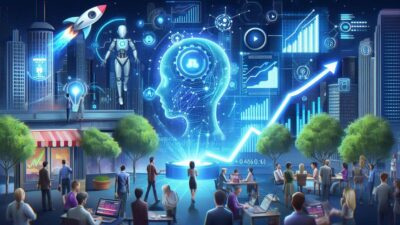
Sales development has always been a high-stakes game—finding leads, qualifying prospects, and moving them through the pipeline requires precision, persistence, and a touch of intuition. But in recent years, AI-powered Sales Development Representatives (AI SDRs) have begun to outpace traditional sales teams in efficiency, scalability, and conversion rates.
Why? Because AI doesn’t sleep, doesn’t get discouraged, and—most importantly—doesn’t rely on guesswork.
The Rise of AI in Sales Development
AI-driven SDRs leverage machine learning, natural language processing (NLP), and predictive analytics to automate and optimize outreach. Unlike human reps, who might struggle with inconsistent follow-ups or subjective lead scoring, AI operates with relentless consistency.
A Harvard Business Review study found that companies using AI for lead generation saw a 50% increase in appointments booked and a 40% reduction in outreach time. The numbers don’t lie—AI is transforming sales development.
How AI SDRs Outperform Humans
| Metric | AI SDRs | Traditional SDRs |
| Response Time | Instant (automated triggers) | Hours or days (manual follow-up) |
| Lead Scoring | Data-driven, highly accurate | Subjective, prone to bias |
| Scalability | Handles thousands of leads at once | Limited by human bandwidth |
| Consistency | 24/7 engagement, no fatigue | Variable performance |
| Cost Efficiency | Lower overhead, no training needed | Salaries, commissions, turnover |
- Speed & Precision in Outreach
AI doesn’t just work fast—it works smart. While a human SDR might take hours to research a lead, an AI-powered tool like Outreach.io or Salesloft can analyze a prospect’s digital footprint in seconds, crafting hyper-personalized emails based on LinkedIn activity, past interactions, and even sentiment analysis.
- Smarter Lead Qualification
Traditional sales teams often waste time chasing dead-end leads. AI eliminates guesswork by using predictive analytics to score leads based on historical data, engagement patterns, and buying signals. Platforms like Gong analyze call transcripts to identify which prospects are most likely to convert.
- Unmatched Follow-Up Discipline
Studies show that 80% of sales require at least five follow-ups, yet most reps give up after two. AI ensures no lead slips through the cracks, automating multi-channel sequences (email, LinkedIn, SMS) with perfect timing.
- Cost-Effective Scaling
Hiring and training SDRs is expensive. According to Glassdoor, the average base salary for an SDR in the U.S. is $55K+, not including commissions. AI SDRs, on the other hand, operate at a fraction of the cost with no turnover risk.
The Human Touch Still Matters—But AI Enhances It
Does this mean human SDRs are obsolete? Not quite. The best sales strategies combine AI efficiency with human intuition. AI handles the grunt work—data crunching, initial outreach, follow-ups—while sales reps focus on high-value conversations and closing deals.
The Future of Sales Development
AI-powered SDRs aren’t just a trend—they’re the new standard. Companies that resist this shift risk falling behind competitors who leverage automation to work faster, smarter, and at scale.





[…] Buyers expect hyper-relevant messaging that speaks to their industry’s unique pain points. An AI SDR can be a game-changer—but only if trained […]